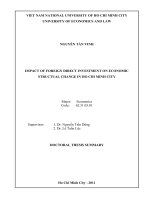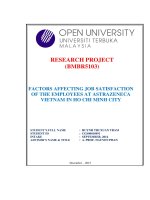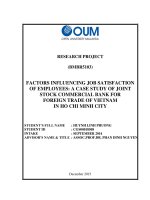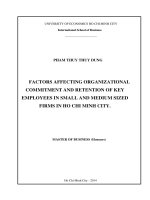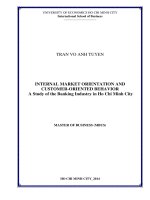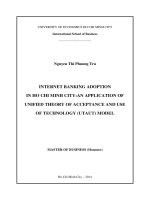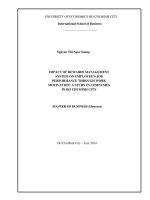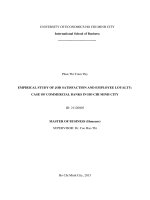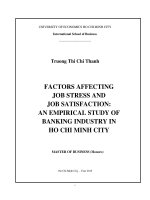Impact of rewards management system on employees job performance through work motivation a study in companies in ho chi minh city
Bạn đang xem bản rút gọn của tài liệu. Xem và tải ngay bản đầy đủ của tài liệu tại đây (963.5 KB, 79 trang )
UNIVERSITY OF ECONOMICS HO CHI MINH CITY
International School of Business
------------------------------
Nguyen Thi Ngoc Suong
IMPACT OF REWARDS MANAGEMENT
SYSTEM ON EMPLOYEE'S JOB
PERFORMANCE THROUGH WORK
MOTIVATION: A STUDY IN COMPANIES
IN HO CHI MINH CITY
MASTER OF BUSINESS (Honours)
Ho Chi Minh City - Year 2014
UNIVERSITY OF ECONOMICS HO CHI MINH CITY
International School of Business
------------------------------
Nguyen Thi Ngoc Suong
IMPACT OF REWARDS MANAGEMENT SYSTEM ON
EMPLOYEE'S JOB PERFORMANCE THROUGH
WORK MOTIVATION: A STUDY IN COMPANIES IN
HO CHI MINH CITY
ID: 22120069
MASTER OF BUSINESS (Honours)
SUPERVISOR:
Dr. TRAN HA MINH QUAN
Ho Chi Minh City - Year 2014
Page |1
ACKNOWLEDGEMENT
I would like to express my sincere appreciation and gratitude to the people who supported
and provided me necessary encouragement to complete the thesis.
To my supervisor, Dr. Tran Ha Minh Quan for his kindly continuous support, guidance,
advise and correction of my thesis.
To colleagues and staffs who willingly participated in the study and provided necessary
data for the study to be completed.
Lastly to my partner, family and friends who encouraged and believed in me.
Page |2
ABSTRACT
Nowaday’s all firms or business entities are facing so many issues related to
employee’s job performance and employee’s work motivation. Getting people feel
motivated to do their best work, is always one of the most challenges of managers in any
organization. And without motivation employees will not put up their best and the
companys performance would be less efficient especially in developing countries where
working conditions are unattractive. As rewards have much impact on employees, which
increase the level of job performance, this study was conducted to is to find out "Impact
of rewards management system on employee’s job performance through work
motivation" in companies in Ho Chi Minh City. With the analysis of data collected
through Questionnaires distributed by respondents, this study indicates that there is a
positive relationship of four mainly focused factors: pay factor, benefits, promotion and
recognition of rewards management system, motivation and job performance of
employees.
Keywords: impact, rewards, rewards management system, work motivation, job
performance.
Page |3
TABLE OF CONTENTS
Contents
ACKNOWLEDGEMENT ................................................................................................... 1
ABSTRACT ........................................................................................................................ 2
TABLE OF CONTENTS .................................................................................................... 3
Chapter I. INTRODUCTION .............................................................................................. 5
1.1 Research background.................................................................................................. 5
1.2 Management problem ................................................................................................. 5
1.3 Research gap ............................................................................................................... 6
1.4 Research objective ...................................................................................................... 7
1.5 Research question ....................................................................................................... 7
1.6 Research significance ................................................................................................. 7
1.7 Research scope ........................................................................................................... 8
1.8 Research structure ...................................................................................................... 8
CHAPTER 2. LITERATURE REVIEW ........................................................................... 10
2.1 Motivation ................................................................................................................ 10
2.2 Theories of motivation ............................................................................................. 11
2.3 Total rewards management system .......................................................................... 15
2.4 Employee job performance....................................................................................... 17
2.5 Relationship among rewards management system, motivation and employee’s job
performance .................................................................................................................... 18
2.6 Hypotheses ............................................................................................................... 18
CHAPTER 3. RESEARCH METHODOLOGY ............................................................... 23
Page |4
3.1 Research design ........................................................................................................ 23
3.2 Data source and collection method .......................................................................... 23
3.3 Measurement scale ................................................................................................... 24
3.4 Sampling design ....................................................................................................... 26
3.5 Data analysis ............................................................................................................. 26
CHAPTER 4. DATA ANALYSIS .................................................................................... 29
4.1 Descriptive statistics of sample ................................................................................ 29
4.2 Measurement scale ................................................................................................... 30
4.3 Exploratory Factor Analysis (EFA) ......................................................................... 31
4.4 Correlation Analysis ................................................................................................. 36
4.5 Regression Analysis ................................................................................................. 38
4.5.1 Regression assumption checking ........................................................................... 38
4.5.2 Hypothesis testing .................................................................................................. 40
4.6 Analysis of Variance (ANOVA) .............................................................................. 44
CHAPTER 5. CONCLUSION AND RECOMMENDATION ......................................... 47
5.1 Conclusion ................................................................................................................ 47
5.2 Recommendations .................................................................................................... 48
5.3 Limitations ................................................................................................................ 49
REFERENCES .................................................................................................................. 50
APPENDIX ...................................................................................................................... 55
Page |5
Chapter I. INTRODUCTION
This chapter represents about introduction of the research which includes
research background, management problem, gap, objectives, questions significance,
scope and structure of the research.
1.1 Research background
Nowadays, it is considered that human resource is the most important factor
leading to the success or failure of a business all over the world, especially in Vietnam.
Development of human resource is one of the most important works in the development
strategy in any organization. A company can have a modern technology, good quality of
service, and even good infrastructure, etc but it may hardly survive and build competitive
advantages in the long term period if lacking of labor force doing work effectively.
As Lawler (2003) said, the way that people are treated increasingly determines
whether an organization will prosper or even survive. An effective organization has to
make sure that there is a strong cooperation and satisfaction among employees. And in
order to make employee perform their best in the organization, there is a need of effective
motivation at various employee’s levels (Bedeian, 1993).
Motivation is a process that energizes, directs, arouses and sustains the behavior
and performance of the employees (Luthans, 1998). Thus, motivation is the process that
stimulates the employees to put their full efforts in order to achieve a desired task (Ishfaq
Ahmed, 2011). And one considerable way to make employees motivated and perform the
best in their job is using rewards management system (Deeprose, 1994). Because, the
rewards have major impact on organizations capability to catch, retain and motivate high
potential employees (Fay and Thompson, 2001).
1.2 Management problem
As the largest commercial and economic center of Vietnam, the economic
activities of Ho Chi Minh City are always vibrant, and strongly attractive for foreign
investments. The economy in this city has grown at a rate of approximately 10% per year
Page |6
of GDP each year. However, there is a fact that, in the current context of global economic
crisis, many companies in Ho Chi Minh City have to think about how to survive
themselves and where to make necessary cuts so that the business will survive. To do the
cuts, they have to reduce staffs, but also keep core employees stay during the recession.
In a meanwhile, there is always a fierce competition among companies to attract
employees, especially those who are skillful and have good experiences through
motivational programs. That leads to difficulties of unstable human resource of a
company when employees try to jump to other places where they think have better
benefit and working mode like Vansteenkiste (2005) used to say: "Today employees are
involved in their working activities which are for their benefits and feel intrinsic
motivation in their behaviors as their activities are enjoyable and satisfactory".
Facing such situation, the big question for management of most companies in Ho
Chi Minh City is how to make employees motivated to work most productively? It is
really a big problem that any managers and leaders in Ho Chi Minh City concern about.
1.3 Research gap
As a motivational method, rewards management system is being applied in many
companies located in Ho Chi Minh City, especially those which have a big capital
invested from abroad. However, should the manager use financial aspects like bonuses,
higher payrolls, pensions, sick allowances, and risk payments, etc as motivators in order
to enhance employee's job performance? If financial motivation has been failed, which
aspect will come? While most managers tend to believe that they can adequately motivate
their workers by offering rewards such as higher pay or bonuses, money may not work as
a motivation for all people because different people will act in different ways (Armstrong
& Stephens, 2005). In fact, there are only few employees who truly contribute their best
to the company but they have been just treated equivalently to those who work less
effectively. And some of employees feel demotivated when benefits of the company have
been suddenly decreased due to the tough economic situation. Hence, it leads to the less
motivation on employees. (Hai Anh, 2013). It means the important point is how to
Page |7
recognize which kind of rewards should be applied for which kind of employee.
Undoubtedly, employees with different attitudes, behaviors, experiences, they need
different way to promote their creativity and capacity as well. Therefore, in order to
motivate an employee so that he can perform his best in the job, it requires a flexible
rewards system. Although there are many studies about employee’s motivation and job
performance in Viet Nam context, there is no official study mentioning about how to
apply rewards management system effectively for various kinds of employees so that
they all can be motivated. This study is try to fulfill this gap by re-measuring the
relationship as well as impact of rewards management system on employee’s
performance with the mediating role of motivation, focusing on four main factors of
rewards named pay factor, benefits, promotion and recognition.
1.4 Research objective
As a consequence of above issue, objective of the study is to investigate the
impact of rewards management system on employee’s performance with the mediating
role of motivation then provides the support to management level on how to apply
rewards management system effectively.
1.5 Research question
The research will address the following specific questions:
1. Is there any relationship between rewards management system, employee's work
motivation and job performance?
2. How does rewards management system impact on work motivation?
3. How does work motivation impact on employee’s job performance?
4. How to apply rewards management system effectively?
1.6 Research significance
In this changing world, employee’s motivation and job performance play
important roles in the development of a company. Therefore, this study tries to find out
the answers of research questions and basing on that helps companies located in Ho Chi
Page |8
Minh City could approach the effective rewards management system which would enable
their employees motivated to show the best job performance.
1.7 Research scope
This study is limited to research on impact of rewards management system on
employee’s performance with the mediating role of motivation in companies in Ho Chi
Minh City. To be convenient, and directly accessible to the objective, this study aims to
employees who are currently working in companies in Ho Chi Minh City as the
respondents for the questionnaire survey. The questionnaire is distributed by respondents
within July, 2014. The study will be ended by September 2014.
1.8 Research structure
The structure is organized with five parts. The first part is about the introduction
of the study. The second one is an integration of literature and hypotheses. The third is
the discussion on research method. Following that, the data analysis process and its
findings are presented in the next parts. And, conclusion of the research is consisting in
the last part.
Chapter 1 provides overview of research background, management problem that
companies in Ho Chi Minh City are facing. As a result, research gap, research objectives,
significances as well as research scope and research structure are identified. It provides a
brief insight into the study.
Chapter 2 provides understanding of rewards management system, motivation
and employee’s job performance. This chapter provides an insight into these concepts by
focusing on previous research in this area and presents reviewed literature relevant to this
study. After that, hypotheses of the research are mentioned.
Chapter 3 describes the research design which is utilized. Specifically, the
chapter describes the sample of the study, measurement approached, how to follow to
collect the data, and the technique used for data analysis.
Page |9
Chapter 4 focuses on transferring, analyzing the primary data then reports on the
results of the empirical analysis. And based on the results, this chapter is to provide
respective discussion as well as findings associated with above literature review.
Chapter 5 comes to conclusion based on findings of the research with
recommendation.
This chapter reflected on the objectives, significances as well as benefits of the
research. The following chapter will provide some insights into the concepts that have an
impact on employee's work motivation and job performance.
P a g e | 10
CHAPTER 2. LITERATURE REVIEW
The focus of this chapter is to provide understanding of rewards management
system, work motivation and employee’s job performance as well as important
relationship among rewards management system, motivation and employee’s job
performance by focusing on the relating theories contents, arguments.
2.1 Motivation
The term of motivation is usually explained as desires, emotions, needs that make
someone do something. In general, motivation is what causes us to act such as drinking a
glass of water to reduce thirst or reading book to gain knowledge, etc.
Motivation is "a set of processes concerned with the force that energizes behavior
and directs it towards attaining some goal" (Baron, 1983). It inspires people to work
individually or in groups in the ways such as to produce to best results to move toward a
goal.
Motivation can be divided into intrinsic and extrinsic motivation. Intrinsic
motivation refers to internal factors such as job satisfaction, responsibility, scope to
develop skills which are driven by an interest or enjoyment in the task itself. It concerns
with the quality of work and has a deep and long effect. Extrinsic motivation refers to
external factors such as a promotion, raise, salary and benefit. This kind of motivation
can have an immediate and powerful effect to encourage an employee but will not really
effect in a long term period. Some employees are motivated intrinsically and other are
motivated extrinsically, while most people tend to be motivated by both forms depending
on the task, time and other situational variables.
There are many theories about motivation from the early beginning of 20th
century. In general, motivation theories can be grouped under categories of contents and
process theories of motivation (Mujtaba 2014). The contents theories of motivation,
which include Maslow’s Hierarchy of Needs, Alderfer’s ERG theory and Herzberg‘s
Two Factor theory are in order to answer the question: "What things motivate people?".
P a g e | 11
And the process theories of motivation which include Vroom’s Expectancy theory,
Adam’s Equity theory and Reinforcement theory are to answer the question: "How are
people motivated?"
2.2 Theories of motivation
2.2.1 Hierarchy of Needs theory
As one of the earliest theories of motivation, Hierarchy of needs theory was
proposed by Abraham Maslow in his paper "A Theory of Human Motivation" in 1943.
Maslow provided a new way of looking human behavior and understanding how humans
are motivated by identifying five specific levels of needs that were organized in a
hierarchy. The needs are starting from the bottom and moving up to the top: physical,
security, social, self-esteem, and self-actualization. In that order:
Physiological needs: these include most basic needs such as need of food, water,
oxygen, salt, sugar; need to rest, to sleep, to have sex, etc. When applying to
organizations, according to Maslow, organizations have to pay employees with a suitable
salary so that they can afford enough their living conditions.
Safety needs is the second level of needs. These needs are activated after
physiological needs are met. They are needs of finding safe circumstances, stability, and
protection. Organizations have to provide employees safe working equipment, health
insurance plans, fire protection so that they can do their jobs in safe and free environment
without any fear or harm.
Belonging needs: present as the third level of needs. They are activated after the
second level of needs is satisfied. Since people are social beings, they have a need to
belong to and be accepted by various groups as well as a need find out meaningful
relations with others. Considering in organizations, leaders and managers should
encourage employees to participate in company events, picnics, team building activities,
etc.
P a g e | 12
Esteem needs: present as the fourth level of needs which includes need of selfrespect, respect and approval by others. Most people have a need for a high evaluation
which is created by recognition and respect from others. When these needs are satisfied,
people become confidence and powerful. People also feel that they are useful and have
some affects on their environment. Therefore, organizations should encourage employee
many kinds of awards for their distinguished achievements.
Self-actualization needs: occupies as the top level of needs. Once esteem needs are
adequately satisfied, the self-actualization needs become activated in order to maximize
ones’ potential. As Maslow expressed: “What a man can be, he must be”, selfactualization is the desire to become what one is capable of becoming. Individuals satisfy
this need in different ways.
Maslow’s theory provies two important insights for researcher and manager. The
first one is that not all people are motivated by similar things. And the second one is that
the same person is not always motivated by the same thing because his or her needs will
change over time. The bussiness should therefore offer different incentively motivational
programs to different employees.
2.2.2 ERG theory
Developed in 1969 by Clayton P. Alderfer, ERG theory was a synchronization of
Maslow’s need hierarchy theory with the simpler classes of needs.
E stands for Existence needs, the basic material necessities. In short, it includes an
individual’s physiological and physical safety needs.
R stands for Relatedness needs. These include the aspiration that individual’s have
for maintaining significant interpersonal relationships.
And, G is Growth needs. These include need for self-development and personal
growth and advancement.
P a g e | 13
According to the ERG theory, if a manager just concentrates on one kind of these
needs at a time, it will not motivate his employee effectively. Managers thus should
understand that each employee has various needs that should be satisfied at the same time.
2.2.3 Two-factor theory
Two-factor theory was developed by Frederick Herzberg in 1959. It describes
about motivators and hygiene factors.
Motivators are concerned with the actual job itself which will directly motivate
employees to work harder. The more interesting work is the more opportunities it will
give for extra responsibilities and promotion. Hygiene factors, in contrast, will not
motivate an employee if it presents but will demotivate the employee if it is absent. They
are factors which are surrounding the job rather than the job itself such as status, salary,
job security, company policy, etc.
According to Herzberg, once motivational factors are met, employee becomes
motivated and hence performs higher. Managers could use to achieve this by some
following methods:
Job enlargement: is to give employees the variety of tasks which are not required
the level of challenge but can make the work more interesting.
Job enrichment: is to involve employees in a wider range of more complex,
interesting and challenging tasks beside a complete unit of work. This one can produce a
greater sense of achievement.
Empowerment: is to delegate more power to employees to make their own
decisions over areas of their working life.
2.2.5 Expectancy theory
Developed by Vroom, Expectancy theory attempts to explain why individuals
choose to follow certain courses of actions in organizations so that they can satisfy needs
and thus becomes motivated. According to Vroom, behavior that employees decide to
P a g e | 14
display depends on what they expect to achieve from the behavior and their motivation
depends on their judgment of how they can perform and what they think that perform will
earn.
There are three levels that link to employees motivation: Expectancy- a desired
level of performance, instrumentality- a desired level of outcome or reward and valence,
the last level of how employees want or do not want the second level outcome. The
higher expectancy, instrumentality and valence are the higher level of motivation
becomes for employees to complete the task with high performance.
2.2.6 Equity theory
Developed by John Stacy Adam in 1963, Equity theory attempts to explain that
motivation comes from input like skills, experience, time on job, seniority, etc. and
output like job title, benefits, salary, responsibility of an individual employee. Depending
on the comparison of input and output factors, the employee can conclude whether his
own input or output is equitable then he can reduce his input and increase his output and
vice versa.
2.2.7 Reinforcement theory
Reinforcement theory "states that individual’s behavior is a function of its
consequences" (Management study guide 2013). Developed by B.F.Skinner, the theory
explains that behavior modification depends on different types of reinforcement
techniques:
positive reinforcement, negative reinforcement, extinction, and
punishment.
Positive reinforcement: Give the incidence to individuals when they have
performed the desired behavior (Griggs, 2009) like praise when they are doing a good job.
Negative reinforcement: it is also a technique of giving incidence of a desired
behavior to individuals. But negative here doesn’t mean bad, it is just a removal of
unpleasant stimulus.
P a g e | 15
Extinction: this technique serves to decrease the incidence of an undesired
behavior. It simply means ignoring a given behavior. It is often an appropriate response
for a minor behavior problem.
Punishment: also designed to decrease the incidence of an undesired behavior. It
does not fit in today value and may cause negative effects if it is applied incorrectly.
2.3 Total rewards management system
Rewards management system is about the processes, policies, strategies and
practices for rewarding its employees in accordance with their contribution, abilities and
artifice. By proving many appropriate types, levels of pays, benefit, and other forms of
reward, etc rewards management system exits in order to motivate employees to work
towards achieving strategic goals (Armstrong, 2003).
As Deeprose (1994) posits, effective rewards management system can help an
organization to achieve its business objectives by attracting and retaining competent
people. The term of rewards management system itself is "significant, implying an active
role for employers" in human resource management strategies (Stephen and Geoff, 2011).
The rewards management system works when an organization wants to motivate
employees to perform their best or when employees accomplished the organizational goal.
It can be used to attract new employees while satisfying current employees. It also
increases efficiency and performance of the employees on their job which can contribute
on the success of the organization. Thus, the rewards management system can help to
reduce the turnover rate.
2.3.1 Rewards management system applications
Rewards management system includes both Financial and Non-Financial Rewards
which are also called as Extrinsic and Intrinsic Rewards.
Extrinsic rewards are salary increase, bonus giving, or others tangible rewards.
This type of rewards is beneficial because it can make the job context more favorable
which makes employee stop thinking about leaving the company.
P a g e | 16
Intrinsic rewards are promotion, praise, recognition, empowerment, etc. These
types of rewards come from the content of the job itself, and encompass motivational
characteristics of the job such as autonomy, role clarity and training (Hackman and
Oldham 1976). They help to give personal satisfaction to individual. Intrinsic rewards
make employee motivated and feel happy with the company.
There are as many elements to be addressed in a rewards management system as
many researches, arguments relating to this topic.
As Armstrong and Murlis (1991) suggest, four main areas that should be
addressed in a rewards management system are:
-
Pay structures in the organization basing on job evaluation;
-
Benefits to satisfy the needs of employees for personal security by providing
remuneration, allowances in forms other than pay;
-
Non-financial
rewards
which
satisfy
employees’
needs
for
challenge,
responsibility, influence in decision-making, recognition and career opportunities,
etc.,
-
And, performance management that provides the basis for continuing as well as
formal reviews of performance against targets, goal setting per year of the
employee.
Hitt, Esser and Marriott (1992) argued that intrinsic rewards including feeling of
challenge, recognition and responsibility; extrinsic rewards like pay, working conditions
and security donated by management of an organization are valuable.
Sarvadi (2005) proposes a strategic reward system should have four different
elements namely compensation, benefit, recognition, and appreciation. Among them,
compensation which includes both of monetary and non-monetary rewards usually is put
in the top, and then followed by benefit.
P a g e | 17
Another argument developed by Wilson in 1994 mentions that a positive reward
system should be: meaningful and valuable to the individual; based on objective, goals;
and balance between work condition in the workplace (extrinsic rewards) and fulfillment
of individual needs (intrinsic rewards).
2.3.2 Recognition
While most employees appreciate monetary rewards for job well done, many
people simply need to be recognized as an individual or a member of a group when they
did a good work. Recognition is defined as "the timely, informal or formal
acknowledgement of a person’s or team’s behavior, effort or business result that supports
the organization’s goals and values, and which has clearly been beyond normal
expectations" (Kim Harrison, 2004). Recognition can be taken by many forms like:
thanks, praise, respect, job opportunity, safe work environment, right tools to do the job,
etc. It is a key success factor even at any levels of management which can make
employees feel appreciated and valued (Sarvadi, 2005).
2.4 Employee job performance
Job performance is defined as "all the behaviors that employees engage in while at
work" (Jex 2002). Job performance refers to how well someone performs at his or her
work. According to Ramlall (2008), a good employee performance is necessary for an
organization, since the organization’s success is dependent on employee’s creativity,
innovation and commitment.
Generally, there are many research discussed about job performance as well as
how to measure it. However, the aim of this thesis is on relationship among rewards
management system, job performance and work motivation. Therefore, a key question to
ask at this juncture is that: What is the relationship among rewards management system,
motivation and job performance?
P a g e | 18
2.5 Relationship among rewards management system, motivation and employee’s
job performance
In recent years, there are many researches were conducted on the same topic and
prove that the more highly rewarded and recognized people are, the more motivation
employees feel hence the better the employees perform their job.
Futrell (1975) explains that “an employee would be motivated to expand a greater
amount of effort in his work if he felt his previous effort had result in his receiving
rewards.”
As Flynn (1998) said, rewards and recognition programs keep high spirits among
employees create motivation for them and thereby, the employees understand their role in
supporting the organization's goal and what they have to do to for the rewards. As a result,
the employees will perform at much higher performance levels.
In the idea of Total Rewards in 2001, Gubman Consulting showed that
"employees look at all of the things offered when they are thinking about if they should
stay, leave or how hard to work". And, as Bob Nelson, author of "1001 Ways to Rewards
Employees" says, appreciation for your best performing people will enhance the
corporate image.
Undoubtedly, rewards management system therefore can be powerful tool for
employee motivation and job performance. Since rewards play a vital role in determining
the significant performance in job and it is positively associated with the process of
motivation, organizations should provide employee relevant levels of rewards and
recognition to make the employees motivated to perform their best in the business's longterm development.
2.6 Hypotheses
There are many researches, papers conducted in general to determine which kinds
in rewards management system affecting on employee’s motivation and job performance.
However, there are four elements of rewards which were repeated many times on
P a g e | 19
afterwards relative researches. Beside the important factor of recognition, the others are
pay factor, employee benefits, promotion.
2.6.1 Pay factor
Pay is an important job attribute from job rewards. According to Pitts (1995), the
principle reward for performing work is payment. If employees are not satisfied with the
rewards package, it will be hard for the company to keep good individuals. Many
employers thus offer reward packages of which wages and salaries are a part of. As
explained by Daniel Wren (2005), one lesson from the evaluation of management is that
managers should not just focus on enhancing production alone but should also think
about how their employees fit into the firm’s equation for success. If the employees are
rewarded with a fair wage, chances are very good that their employees will be motivated
which may lead to better ways of doing the job (Mujtaba, 2010).
With above influences of pay factor, the first hypothesis is as below:
H1: Pay factor has a positive and significant impact on employee motivation.
2.6.2 Benefits
Benefits that employee receive apart from pay play an important role in the
rewards management system which is used to motivate employee. Beer et al. (1984)
argued in his study that organization should reward employee because in return, they are
looking for certain kinds of behavior: they need individuals who agree to work with their
best. Individual employees, in exchange, they expect to receive rewards of which benefits
are important. It is also may be acquired to allow employees to set themselves
challenging goals that they may attain via differing means they may perceive as
instrumental towards those goals (Spector, 2003). Organization therefore should motivate
their employee by offering financial as well as non financial benefits (Simon and DeVaro,
2006).
So, from the importance of benefits, the second hypothesis is:
P a g e | 20
H2: Benefits has a positive and significant impact on employee motivation.
2.6.3 Promotion
Every year, most of employees in an organization eagerly wait for the day when
their efforts and achievements during the year would be evaluated and appreciated.
Beside incentives, rise in salary, employee benefits etc given to them, one of the most
important factors in rewards management system to keep them motivated is "Promotion".
Fair chances of promotion according to employee’s ability and skills make employee
more loyal to their work and become a source of pertinent workability for the employee
(Deeprose 1994). Promotions assign workers to jobs better suiting their abilities and
quickly move up talented workers (Gibbons 1997).
Based on above arguments relating to importance of promotion in the way
motivating employee, the third hypotheses is developed as below:
H3: Promotion has a positive and significant impact on employee motivation.
2.6.4 Recognition
As presenting in above literature review, recognition is one of the most factors
which can’t be lacked in rewards management system. It is considered as "esteem needs"
in hierarchy of Maslow’s need theory. Cash awards are good but in general, are not very
effective in the long-term, and they are not always very popular either (Joinson, 1996),
because many people want to be respected and valued for their contribution. As Ali and
Ahmed (2009) said, recognition can bring a positive change in work motivation of the
employee. When employees and their work are valued, their satisfaction and productivity
rises, and as a result of this, they are motivated to maintain or improve their good work.
Therefore, with the necessary of recognition in motivating employee, the fourth
hypothesis is:
H4: Recognition has a positive and significant impact on employee motivation.
P a g e | 21
2.6.5 Motivation
For years, researchers have argued that the most highly motivated employees are
the employees who will reach the highest level of job performance.
According to Mol (1992), individuals trend to move if they find that they carried
out tasks just for being paid. And only when they feel that they are motivated, they will
totally involve in the tasks.
La Motta (1995) states that job performance as the result of motivation and ability.
Ability here includes training, education, equipment, and simplicity of task, experience.
An employee may still not perform well on the job if the motivation is not directed at that
particular task. Supporting on this idea, Lawler (2003) said that motivated workers will
not achieve results if they do not have the necessary skills, expertise and attitude that the
organization requires of them.
H5: Motivation has a positive and significant impact on employee’s job
performance.
Research Model:
According to above hypotheses, a research model of this study has been built as
below:
P a g e | 22
Overall, this chapter is evident that a good reward management system can create
people’s motivation and their willingness to do the best on their job. Although there are
many factors of rewards management system that influence employee's work motivation
and job performance in companies in Ho Chi Minh City, this study just focuses on four
main factors: pay factor, benefits, promotion, and recognition.
P a g e | 23
CHAPTER 3. RESEARCH METHODOLOGY
In this chapter, the practical methods which were used in order to answer the
research questions and fulfill the purpose of this study are presented.
3.1 Research design
This research used both of qualitative and quantitative research method to achieve
wide and clear understanding of the chosen object.
Qualitative research method was done by a pilot interview with a focus group.
Interviewees who joined the discussion were directly asked one by one statement in the
measurement scales to check if they could understand clearly and correctly the content
and meaning of words mentioned in each statement of the measurement scale. Thereby,
official measurement scales for quantitative research would be developed after modifying
the words correspondingly.
Quantitative method was based on already decided and well-structured questions,
which all the respondents would be asked about. By using questionnaire created from
literature review, the research aimed to test the impact of four factor of rewards
management system: pay factor, benefits, promotion and recognition on employee’s job
performance through motivation. It could be conducted on a large scale and give a lot
more information as far as value and statistics.
3.2 Data source and collection method
3.2.1 Primary data
Primary was collected by using a structured questionnaire. The questionnaire was
distributed in two different ways. One was to send it by an e-mail attached a link to an
online survey with the advantages of low cost and availability to cover a large group of
participants. And the second way was that the questionnaire was distributed directly by
hand with the advantage of completion request right away.
3.2.2 Secondary data
